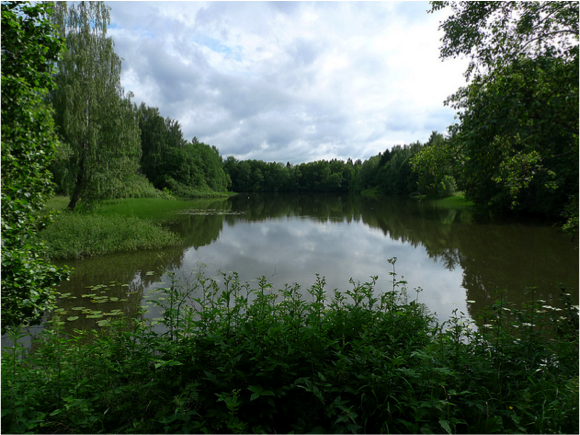
The Blylagsdammen is a dam bordering the Northern Frogn area. It is surrounded by houses polluting the dam. Source: JENSSEN (2012)
This case study explores the municipality of Frogn, Norway, where homes rely on decentralised systems for water and sanitation (see also decentralised supply). These decentralised systems are very simple and do not meet the quality standards of the municipality, therefore a centralised water and wastewater system has been planned. Due to the high cost that would be incurred by individual homeowners for the installation of the system, there has been strong opposition to the planned centralised system. Therefore, the municipal council has required that a decentralised system must be presented as an alternative to the high-cost centralised system.
In order to evaluate which would be the best solution for Frogn, this case study provides resources to answer the following questions: What is the current status of water and wastewater management in Frogn? What are the advantages and disadvantages of centralised versus decentralised systems? What kinds of decentralised water and wastewater systems can be used, and which would be most suitable for Frogn? To answer these questions, aspects of pollution (see also water pollution), health and hygiene (see also water sanitation and health), preferences of the citizens/stakeholders (see also stakeholder analysis), as well as operation and maintenance are considered.
Exceeding Tertiary Standards with a Pond/Reed Bed System in Norway
Case study about a combined pond / constructed wetland system in cold climate for 160 peoples, a dairy and food processing workshop, a bakery and a laundry. A vertical flow constructed wetlands was installed for pre-treatment, followed by a deep enhanced facultative pond, three aerated stabilization ponds, a planted sand filter and finally tow horizontal-flow constructed wetlands.
BROWNE, P.D. ; JENSSEN, P.D. (2005): Exceeding Tertiary Standards with a Pond/Reed Bed System in Norway. In: Journal of Water Science and Technology: Volume 51 , 299-306. URL [Accessed: 03.06.2019]Decentralized Systems Technology Fact Sheet - Mound Systems
Mounds are decentralised wastewater treatment systems whose main purpose is to provide sufficient treatment to the natural environment to produce an effluent equivalent to, or better than, a conventional onsite disposal system. Mounds are pressure-dosed sand filters that discharge directly to natural soil. They lie above the soil surface and are designed to overcome site restrictions such as: slow or fast permeability soils, shallow soil cover over creviced or porous bedrock, or a high water table.
EPA (1999): Decentralized Systems Technology Fact Sheet - Mound Systems. Washington D.C.: United States Environmental Protection Agency (EPA) URL [Accessed: 06.09.2012]Subsurface Flow Constructed Wetlands for Wastewater Treatment
This document presents a technical review of subsurface flow (SF) constructed wetlands as a decentralised wastewater treatment system. It supports that SF constructed wetlands can be a reliable and cost-effective treatment method for a wide range of wastewaters, with applications ranging from single family dwellings, parks, schools, and other public facilities to municipalities and industries.
EPA (1993): Subsurface Flow Constructed Wetlands for Wastewater Treatment. A Technology Assessment. Washington D.C.: United States Environmental Protection Agency (EPA) URL [Accessed: 06.09.2012]Wastewater Technology Fact Sheet - Intermittent Sand Filters
This factsheet describes the use of intermittent sand filters (ISF) for decentralised wastewater treatment, including the different types of intermittent sand filters, their advantages and disadvantages, performance, applicability, operation and maintenance, and cost.
EPA (1999): Wastewater Technology Fact Sheet - Intermittent Sand Filters. Washington D.C.: United States Environmental Protection Agency (EPA) URL [Accessed: 06.09.2012]Wastewater Technology Fact Sheet - Package Plants
Package plants are pre-manufactured treatment facilities used to treat wastewater in small communities or on individual properties. The most common types of package plants are extended aeration plants, sequencing batch reactors, oxidation ditches, contact stabilization plants, rotating biological contactors, and physical/chemical processes. This fact sheet focuses on the first three, all of which are biological aeration processes.
EPA (2000): Wastewater Technology Fact Sheet - Package Plants. Washington D.C.: United States Environmental Protection Agency (EPA) URL [Accessed: 06.09.2012]Wastewater Technology Fact Sheet - Free Water Surface Wetlands
Free water surface (FWS) wetlands are defined as wetland systems where the water surface is exposed to the atmosphere. FWS wetlands are natural wastewater treatment systems which can effectively remove pollutants like particulates, nitrogen, phosphorus, and complex organic compounds. This factsheet provides an overview of the advantages and disadvantages of using FWS wetlands for wastewater treatment.
EPA (2000): Wastewater Technology Fact Sheet - Free Water Surface Wetlands. Washington D.C.: United States Environmental Protection Agency (EPA) URL [Accessed: 06.09.2012]Wastewater Technology Fact Sheet - Wetlands: Subsurface Flow
A subsurface flow (SF) wetland is specifically designed for the treatment or polishing of some type of wastewater and are typically constructed as a bed or channel containing appropriate media. The main advantages of this subsurface water level are prevention of mosquitoes and odors, and elimination of the risk of public contact with the partially treated wastewater.
EPA (2000): Wastewater Technology Fact Sheet - Wetlands: Subsurface Flow. Washington D.C.: United States Environmental Protection Agency (EPA) URL [Accessed: 06.09.2012]The Centralized Alternative
This document outlines aspects of the proposed centralised water and wastewater system in Frogn. Information is provided regarding the characteristics of the system for both water supply and wastewater collection and treatment, as well an estimate of the costs involved in installing such a system.
JENSSEN, P.D. (n.y): The Centralized Alternative. Frogn Case - Water Pollution. Aas: Norvergian University of Life Science (UMB)Frogn Case - The Existing Water Supply
Frogn Case - The Existing Wastewater Situation
This document outlines the current wastewater management in Frogn, including information on the types and performance of toilet systems used, greywater treatment systems, and wastewater treatment systems.
JENSSEN, P.D. (n.y): Frogn Case - The Existing Wastewater Situation. Aas: Norvergian University of Life Science (UMB)Water Pollution in the Area before and after Upgrading of the Sanitary Systems
This document provides information on the pollution sources and quantities in Frogn before and after the upgrading of decentralised wastewater treatment systems.
JENSSEN, P.D. (n.y): Water Pollution in the Area before and after Upgrading of the Sanitary Systems. Aas: Norvergian University of Life Science (UMB)Technology Assessment of Wastewater Treatment by Soil Infiltration Systems
Infiltration of wastewater in buried soil infiltration systems has been promoted as a low cost, effective alternative for treatment and disposal of wastewater flows from commercial developments and small communities. However, design and performance relationships are not always well defined and systems are often implemented based on local tradition and empiricism. This paper describes design criteria especially for large subsurface wastewater treatment systems.
JENSSEN, P.D. ; SIEGRIST, R.L. (1990): Technology Assessment of Wastewater Treatment by Soil Infiltration Systems. In: Water Science & Technology: Volume 22 , 83-92. URL [Accessed: 23.01.2019]Sustainable Wastewater Management in Urban Areas
A document about sustainable wastewater management in urban areas.
JENSSEN, P.D. GREATOREX, J.M. WARNER, W. S. (2004): Sustainable Wastewater Management in Urban Areas. (= Kapitel 4. Kurs WH33, Konzeptionen dezentralisierter Abwasserreinigung und Stoffstrommanagement ). Hannover: University of HannoverHigh Performance Constructed Wetlands for Cold Climates
In 1991, the first subsurface flow constructed wetland for treatment of domestic wastewater was built in Norway. Today, this method is rapidly becoming a popular method for wastewater treatment in rural Norway. This is due to excellent performance even during winter and low maintenance. The systems can be constructed regardless of site conditions.
JENSSEN, P.D. ; MAEHLUM, T. ; KROGSTAD, T. ; VRALE, L. (2005): High Performance Constructed Wetlands for Cold Climates. In: Journal of Environmental Science and Health: Volume 40 , 1343-1353.A Complete Recycling (Ecosan) System at Student Dormitories in Norway
This document describes an ecosan recycling system that was implemented in a dormitory of 48 students. It reduced water consumption by 30%, nearly eliminated pollution, and produced valuable plant fertiliser and soil amendment product from the waste material.
JENSSEN, P.D. (2005): A Complete Recycling (Ecosan) System at Student Dormitories in Norway. In: BOHEMEN, H. (2005): Ecological Engineering. Bridging Between Ecology and Civil Engineering. Netherlands: 81-83. URL [Accessed: 06.09.2012]Decentralized Urban Greywater Treatment at Klosterenga Oslo
Today it is possible to foresee completely decentralized wastewater treatment systems in urban areas where the blackwater fractions (urine and faecal matter) is reclaimed for fertilizer and potentially energy production. The water from kitchen sinks and showers (greywater) is treated locally in compact low maintenance systems that constitute attractive landscape elements. These systems can coexist with decentralized water supply.
JENSSEN, P. (2005): Decentralized Urban Greywater Treatment at Klosterenga Oslo. In: Ecological Engineering-Bridging between Ecology and Civil Engineering: , 84-86. URL [Accessed: 21.02.2012]Funksjonskontroll av renseanlegg i spredt bebyggelse i Morsa-vassdraget
Language: Swedish
Urine Separation - Closing the Nutrient Cycle
This report presents the present state of knowledge about urine-separating toilets and systems for the recirculation of urine as an agricultural fertilizer. It contains a description of urine separation technology and how a system can be constructed for recirculating urine from residential districts to farmland. It also contains concrete recommendations about planning and management of the various components of the system.
JOHANSSON, M. (2000): Urine Separation - Closing the Nutrient Cycle. Final Report of the R&D Project: Source-Separated Human Urine - A Future Source of Fertilizer for Agriculture in the Stockholm Region. Stockholm: Stockholm Vatten, Stockholmshem & HSB National Federation URL [Accessed: 31.05.2019]Energy and Sewage
Water and energy management are important and interrelated issues. While sewage treatment has improved significantly over the past 20 years, the energy required to treat sewage to this standard is high, leading to high treatment costs. This document evaluates options for sewage treatment in terms of energy conservation and renewable energy generation.
POST (2007): Energy and Sewage. (= postnote , 282 ). London, U.K.: Parliamentary Office of Science and Technology (POST) URL [Accessed: 06.09.2012]Design Manual: Constructed Wetlands for the Treatment of Black Water
Constructed wetlands are natural, decentralised wastewater treatment systems that can be used in a variety of contexts. This document provides practical information on the implementation of constructed wetlands for treating wastewater, including design, materials, construction, and maintenance.
SETTY, K. (n.y): Design Manual: Constructed Wetlands for the Treatment of Black Water. Santa Barbara, California: URL [Accessed: 06.09.2012]Design and Performance of Onsite Wastewater Soil Absorption Systems
This document describes onsite wastewater soil absorption systems (WSAS), which have the potential to achieve high treatment efficiencies over a long life service at low cost. Information is given on the function and performance of WSAS, the current state of knowledge, and identifying major gaps in predicting system performance.
SIEGRIST, R.L. TYLER, E.J. JENSSEN, P.D. (2000): Design and Performance of Onsite Wastewater Soil Absorption Systems. (= National Research Needs Conference, May 2000 ). St. Louis, MO:Waste Stabilization Ponds and Constructed Wetlands Manual.
Design manual for designers, builders and operators on the design and operation of artificially constructed wetlands and waste stabilization ponds. The supporting information includes a standard systems approach which can be adopted universally; the theoretical background on the biological, chemical and physical processes of each method, the current state of the technology and technical knowledge on how to design, operate and maintain them; and theoretical knowledge on how best the models may be used to describe the systems.
UNEP (n.y): Waste Stabilization Ponds and Constructed Wetlands Manual. . United Nations Environmental Programme International Environmental Technology Center (UNEP-IETC) and the Danish International Development Agency (Danida) URL [Accessed: 19.04.2010]http://www.youtube.com/
Film about the function of a constructed wetland according to Norwegian design (cold climate). The film is made by Maxit the manufacturer of Filtralite an expanded clay product with high porosity and a large surface area. These qualities make the Filtralite very well suited as filter media for treating water.


